Enhancement of Spin Transport Properties in Angled-Channel Graphene Spin Valves via Hybrid Spin Drift-Diffusion
Abstract
1. Introduction
2. Materials and Methods
2.1. Device Design and Fabrication
2.2. Device Characterization
3. Results and Discussion
3.1. Graphene Quality
3.2. 45° Hybrid Drift-Diffusion Spin Valves
3.3. 90° Hybrid Drift-Diffusion Spin Valves
4. Conclusions
Author Contributions
Funding
Data Availability Statement
Acknowledgments
Conflicts of Interest
References
- Žutić, I.; Fabian, J.; Das Sarma, S. Spintronics: Fundamentals and applications. Rev. Mod. Phys. 2004, 76, 323–410. [Google Scholar] [CrossRef]
- Hirohata, A.; Yamada, K.; Nakatani, Y.; Prejbeanu, I.-L.; Diény, B.; Pirro, P.; Hillebrands, B. Review on spintronics: Principles and device applications. J. Magn. Magn. Mater. 2020, 509, 166711. [Google Scholar] [CrossRef]
- Barla, P.; Joshi, V.K.; Bhat, S. Spintronic devices: A promising alternative to CMOS devices. J. Comput. Electron. 2021, 20, 805–837. [Google Scholar] [CrossRef]
- Guo, Z.; Yin, J.; Bai, Y.; Zhu, D.; Shi, K.; Wang, G.; Cao, K.; Zhao, W. Spintronics for Energy- Efficient Computing: An Overview and Outlook. Proc. IEEE 2021, 109, 1398–1417. [Google Scholar] [CrossRef]
- Hrkac, G.; Dean, J.; Allwood, D.A. Nanowire spintronics for storage class memories and logic. Philos. Trans. R. Soc. A Math. Phys. Eng. Sci. 2011, 369, 3214–3228. [Google Scholar] [CrossRef] [PubMed]
- Dieny, B.; Prejbeanu, I.L.; Garello, K.; Gambardella, P.; Freitas, P.; Lehndorff, R.; Raberg, W.; Ebels, U.; Demokritov, S.O.; Akerman, J.; et al. Opportunities and challenges for spintronics in the microelectronics industry. Nat. Electron. 2020, 3, 446–459. [Google Scholar] [CrossRef]
- Inomata, K.; Ikeda, N.; Tezuka, N.; Goto, R.; Sugimoto, S.; Wojcik, M.; Jedryka, E. Highly spin-polarized materials and devices for spintronics∗. Sci. Technol. Adv. Mater. 2008, 9, 014101. [Google Scholar] [CrossRef]
- Fabian, J.; Das Sarma, S. Spin relaxation of conduction electrons. J. Vac. Sci. Technol. B Microelectron. Nanometer Struct. 1999, 17, 1708–1715. [Google Scholar] [CrossRef]
- Das Sarma, S.; Fabian, J.; Hu, X.; Zutic, I. Theoretical perspectives on spintronics and spin-polarized transport. IEEE Trans. Magn. 2000, 36, 2821–2826. [Google Scholar] [CrossRef]
- Han, W.; McCreary, K.; Pi, K.; Wang, W.; Li, Y.; Wen, H.; Chen, J.; Kawakami, R. Spin transport and relaxation in graphene. J. Magn. Magn. Mater. 2012, 324, 369–381. [Google Scholar] [CrossRef]
- Huertas-Hernando, D.; Guinea, F.; Brataas, A. Spin-orbit coupling in curved graphene, fullerenes, nanotubes, and nanotube caps. Phys. Rev. B 2006, 74, 155426. [Google Scholar] [CrossRef]
- Johnson, M.; Silsbee, R.H. Interfacial charge-spin coupling: Injection and detection of spin magnetization in metals. Phys. Rev. Lett. 1985, 55, 1790–1793. [Google Scholar] [CrossRef]
- Ji, Y.; Hoffmann, A.; Jiang, J.S.; E Pearson, J.; Bader, S.D. Non-local spin injection in lateral spin valves. J. Phys. D Appl. Phys. 2007, 40, 1280–1284. [Google Scholar] [CrossRef]
- Bass, J.; Pratt, W.P. Spin-diffusion lengths in metals and alloys, and spin-flipping at metal/metal interfaces: An experimentalist’s critical review. J. Phys. Condens. Matter 2007, 19, 183201. [Google Scholar] [CrossRef]
- Fukuma, Y.; Wang, L.; Idzuchi, H.; Takahashi, S.; Maekawa, S.; Otani, Y. Giant enhancement of spin accumulation and long-distance spin precession in metallic lateral spin valves. Nat. Mater. 2011, 10, 527–531. [Google Scholar] [CrossRef]
- Han, W.; Kawakami, R.K.; Gmitra, M.; Fabian, J. Graphene spintronics. Nat. Nanotechnol. 2014, 9, 794–807. [Google Scholar] [CrossRef]
- Tombros, N.; Tanabe, S.; Veligura, A.; Jozsa, C.; Popinciuc, M.; Jonkman, H.T.; van Wees, B.J. Anisotropic Spin Relaxation in Graphene. Phys. Rev. Lett. 2008, 101, 046601. [Google Scholar] [CrossRef] [PubMed]
- Huertas-Hernando, D.; Guinea, F.; Brataas, A. Spin-Orbit-Mediated Spin Relaxation in Graphene. Phys. Rev. Lett. 2009, 103, 146801. [Google Scholar] [CrossRef] [PubMed]
- Vila, M.; Garcia, J.H.; Cummings, A.W.; Power, S.R.; Groth, C.W.; Waintal, X.; Roche, S. Nonlocal Spin Dynamics in the Crossover from Diffusive to Ballistic Transport. Phys. Rev. Lett. 2020, 124, 196602. [Google Scholar] [CrossRef]
- Stecklein, G.; Crowell, P.A.; Li, J.; Anugrah, Y.; Su, Q.; Koester, S.J. Contact-Induced Spin Relaxation in Graphene Nonlocal Spin Valves. Phys. Rev. Appl. 2016, 6, 054015. [Google Scholar] [CrossRef]
- Volmer, F.; Drögeler, M.; Maynicke, E.; Driesch, N.v.D.; Boschen, M.L.; Güntherodt, G.; Beschoten, B. Role of MgO barriers for spin and charge transport in Co/MgO/graphene nonlocal spin-valve devices. Phys. Rev. B 2013, 88, 161405. [Google Scholar] [CrossRef]
- Volmer, F.; Drögeler, M.; Pohlmann, T.; Güntherodt, G.; Stampfer, C.; Beschoten, B. Contact-induced charge contributions to non-local spin transport measurements in Co/MgO/graphene devices. 2D Mater. 2015, 2, 024001. [Google Scholar] [CrossRef]
- Volmer, F.; Drögeler, M.; Maynicke, E.; Driesch, N.v.D.; Boschen, M.L.; Güntherodt, G.; Stampfer, C.; Beschoten, B. Suppression of contact-induced spin dephasing in graphene/MgO/Co spin-valve devices by successive oxygen treatments. Phys. Rev. B 2014, 90, 165403. [Google Scholar] [CrossRef]
- Ertler, C.; Konschuh, S.; Gmitra, M.; Fabian, J. Electron spin relaxation in graphene: The role of the substrate. Phys. Rev. B 2009, 80, 041405. [Google Scholar] [CrossRef]
- Habib, A.; Xu, J.; Ping, Y.; Sundararaman, R. Electric fields and substrates dramatically accelerate spin relaxation in graphene. Phys. Rev. B 2022, 105, 115122. [Google Scholar] [CrossRef]
- Van Tuan, D.; Ortmann, F.; Cummings, A.W.; Soriano, D.; Roche, S. Spin dynamics and relaxation in graphene dictated by electron-hole puddles. Sci. Rep. 2016, 6, 21046. [Google Scholar] [CrossRef]
- Thomsen, M.R.; Ervasti, M.M.; Harju, A.; Pedersen, T.G. Spin relaxation in hydrogenated graphene. Phys. Rev. B 2015, 92, 195408. [Google Scholar] [CrossRef]
- Wellnhofer, S.; Stabile, A.; Kochan, D.; Gmitra, M.; Chuang, Y.-W.; Zhu, J.; Fabian, J. Spin relaxation in fluorinated single and bilayer graphene. Phys. Rev. B 2019, 100, 035421. [Google Scholar] [CrossRef]
- Olson, S.T.; Still, D.; Hood, K.; Zietz, O.; Jiao, J. Impact of material and tunnel barrier quality on spin transport in a CVD graphene non-local spin valve device array. Carbon Trends 2023, 13, 100300. [Google Scholar] [CrossRef]
- Zhou, J.; Hu, T.; Dong, J.; Kawazoe, Y. Ferromagnetism in a graphene nanoribbon with grain boundary defects. Phys. Rev. B 2012, 86, 035434. [Google Scholar] [CrossRef]
- Neumann, I.; Van de Vondel, J.; Bridoux, G.; Costache, M.V.; Alzina, F.; Torres, C.M.S.; Valenzuela, S.O. Electrical Detection of Spin Precession in Freely Suspended Graphene Spin Valves on Cross-Linked Poly(methyl methacrylate). Small 2012, 9, 156–160. [Google Scholar] [CrossRef]
- Zomer, P.J.; Guimarães, M.H.D.; Tombros, N.; van Wees, B.J. Long-distance spin transport in high-mobility graphene on hexagonal boron nitride. Phys. Rev. B 2012, 86, 161416. [Google Scholar] [CrossRef]
- Drögeler, M.; Franzen, C.; Volmer, F.; Pohlmann, T.; Banszerus, L.; Wolter, M.; Watanabe, K.; Taniguchi, T.; Stampfer, C.; Beschoten, B. Spin Lifetimes Exceeding 12 ns in Graphene Nonlocal Spin Valve Devices. Nano Lett. 2016, 16, 3533–3539. [Google Scholar] [CrossRef] [PubMed]
- Bisswanger, T.; Winter, Z.; Schmidt, A.; Volmer, F.; Watanabe, K.; Taniguchi, T.; Stampfer, C.; Beschoten, B. CVD Bilayer Graphene Spin Valves with 26 μm Spin Diffusion Length at Room Temperature. Nano Lett. 2022, 22, 4949–4955. [Google Scholar] [CrossRef] [PubMed]
- Ingla-Aynés, J.; Meijerink, R.J.; van Wees, B.J. Eighty-Eight Percent Directional Guiding of Spin Currents with 90 μm Relaxation Length in Bilayer Graphene Using Carrier Drift. Nano Lett. 2016, 16, 4825–4830. [Google Scholar] [CrossRef]
- Venica, S.; Driussi, F.; Gahoi, A.; Palestri, P.; Lemme, M.C.; Selmi, L. On the Adequacy of the Transmission Line Model to Describe the Graphene–Metal Contact Resistance. IEEE Trans. Electron Devices 2018, 65, 1589–1596. [Google Scholar] [CrossRef]
- Han, W.; Pi, K.; Wang, W.H.; McCreary, K.M.; Li, Y.; Bao, W.; Wei, P.; Shi, J.; Lau, C.N.; Kawakami, R.K.; et al. Spin Transport in Graphite and Graphene Spin Valves; SPIE NanoScience + Engineering: San Diego, CA, USA, 2009; p. 739819. [Google Scholar]
- Ferrari, A.C.; Meyer, J.C.; Scardaci, V.; Casiraghi, C.; Lazzeri, M.; Mauri, F.; Piscanec, S.; Jiang, D.; Novoselov, K.S.; Roth, S.; et al. Raman spectrum of graphene and graphene layers. Phys. Rev. Lett. 2006, 97, 187401. [Google Scholar] [CrossRef]
- Han, W.; Pi, K.; McCreary, K.M.; Li, Y.; Wong, J.J.I.; Swartz, A.G.; Kawakami, R.K. Tunneling Spin Injection into Single Layer Graphene. Phys. Rev. Lett. 2010, 105, 167202. [Google Scholar] [CrossRef]
- Khokhriakov, D.; Karpiak, B.; Hoque, A.M.; Dash, S.P. Two-dimensional spintronic circuit architectures on large scale graphene. Carbon 2020, 161, 892–899. [Google Scholar] [CrossRef]
- Józsa, C.; Popinciuc, M.; Tombros, N.; Jonkman, H.T.; van Wees, B.J. Electronic Spin Drift in Graphene Field-Effect Transistors. Phys. Rev. Lett. 2008, 100, 236603. [Google Scholar] [CrossRef]
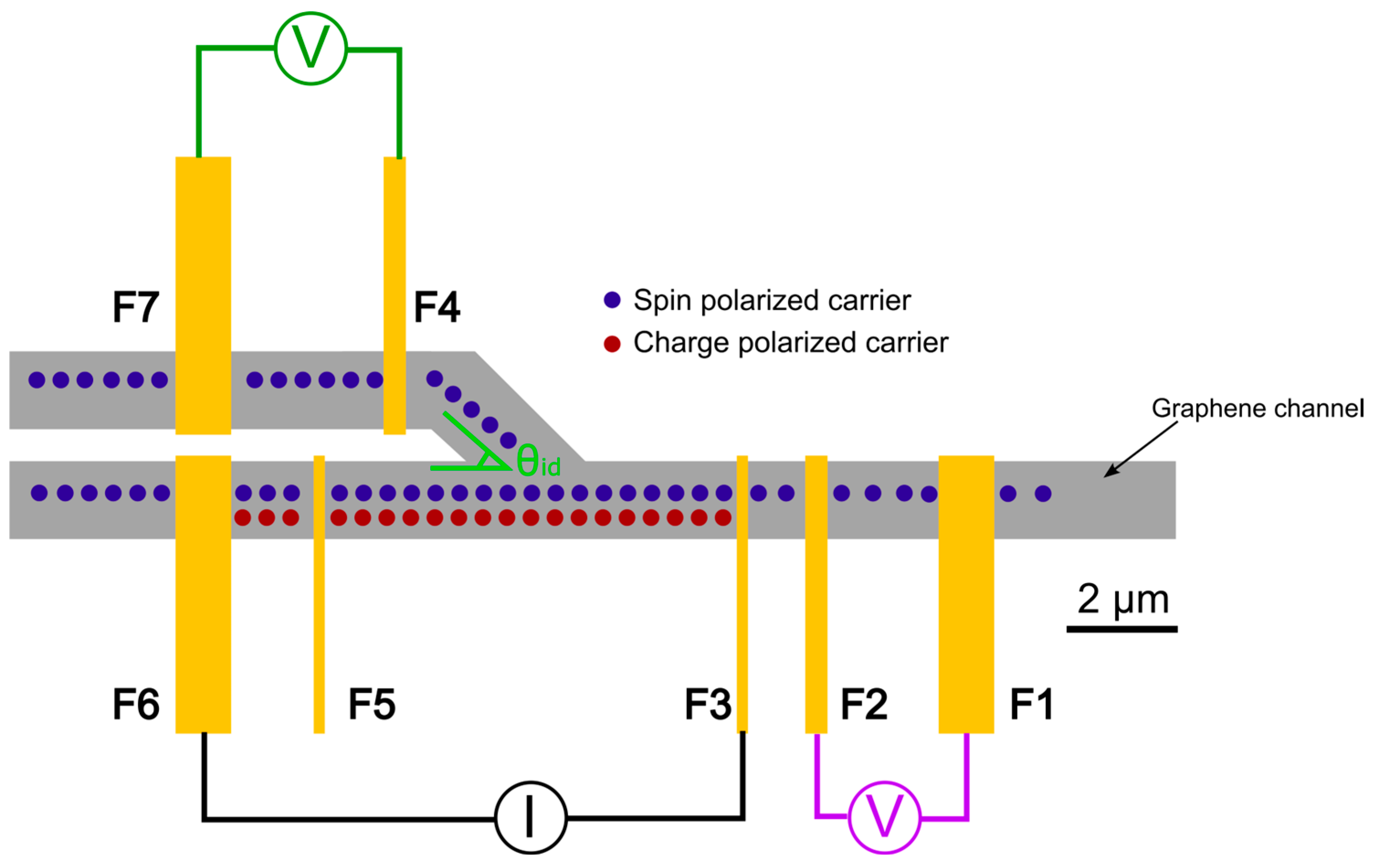
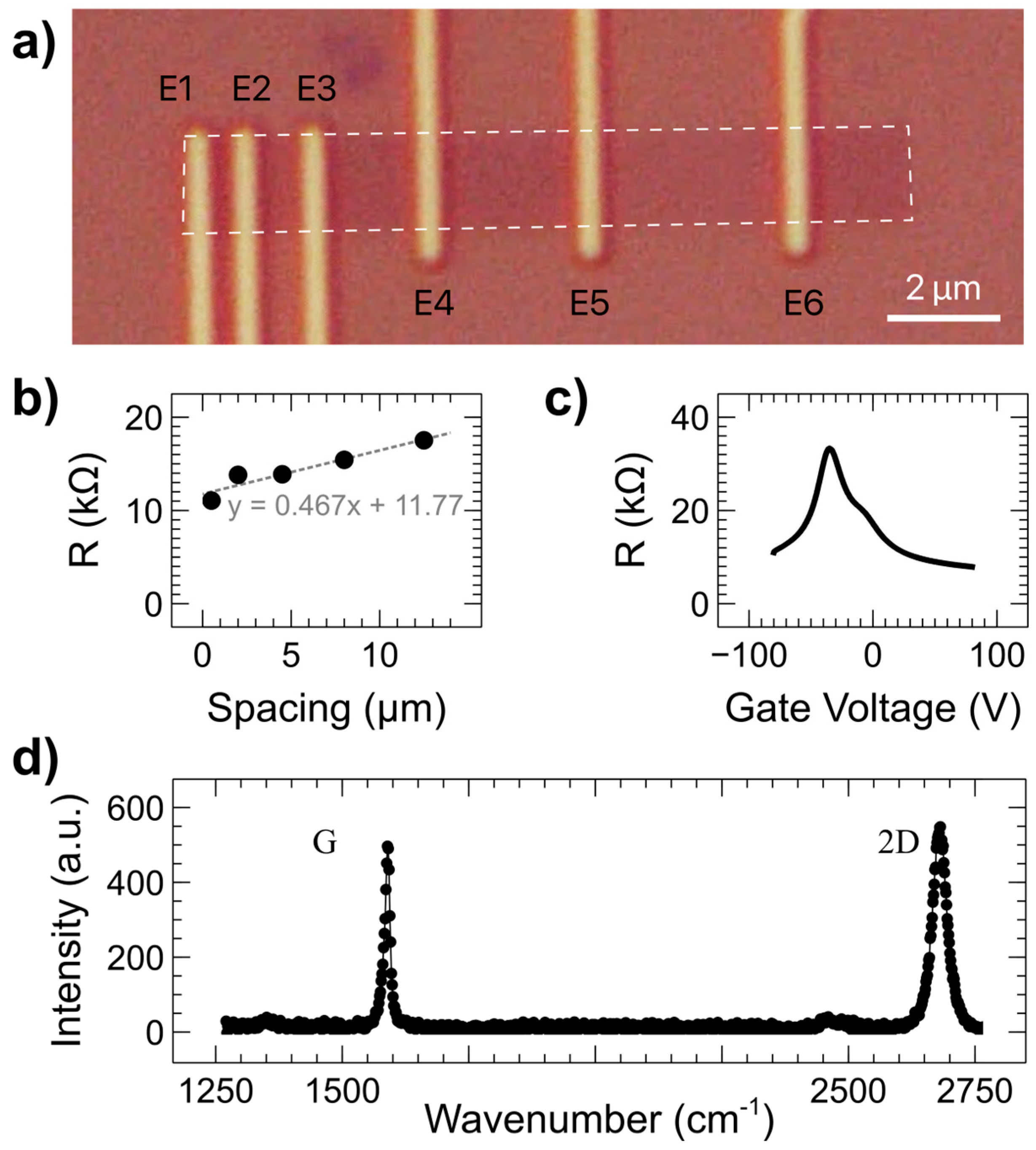
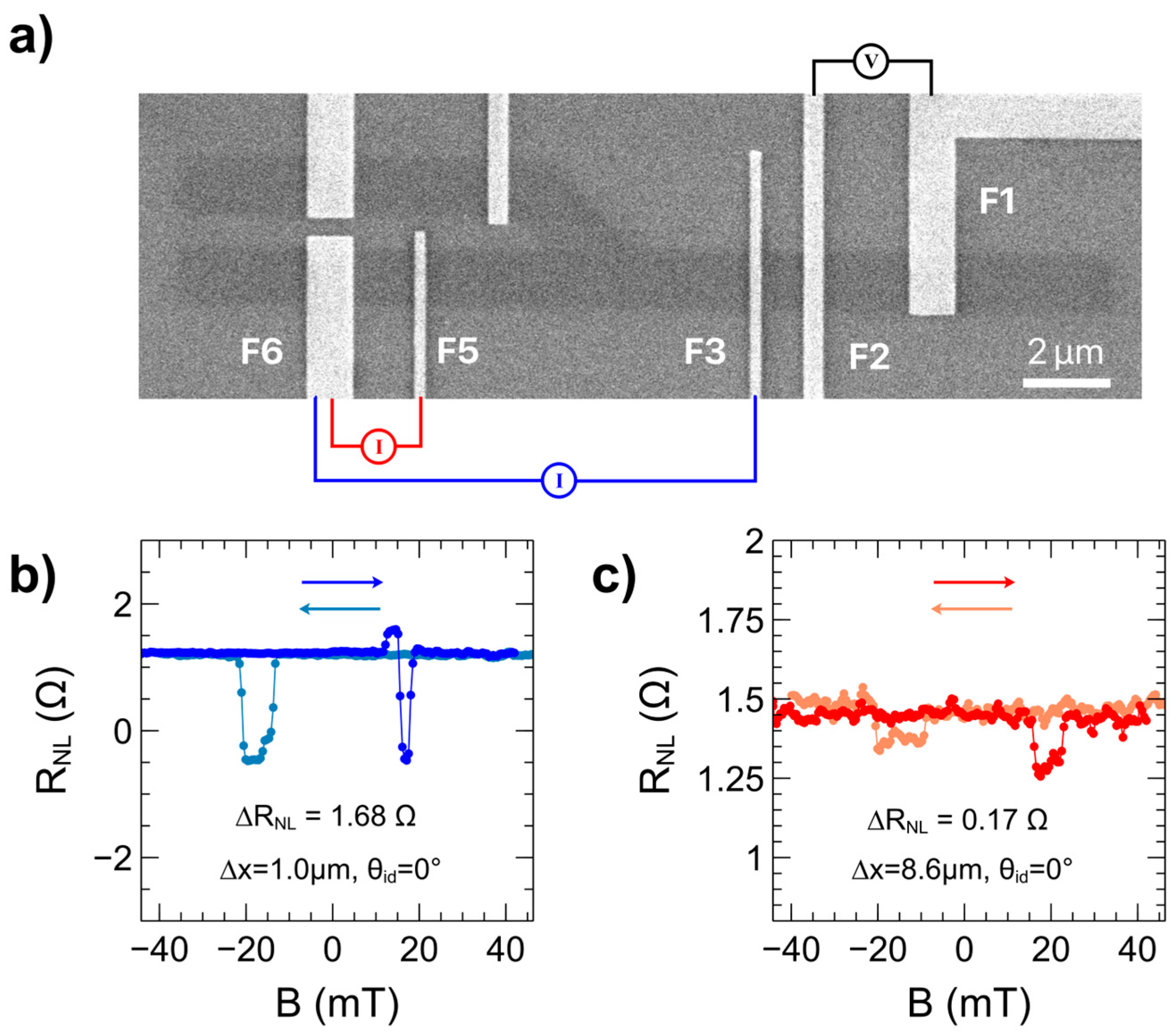
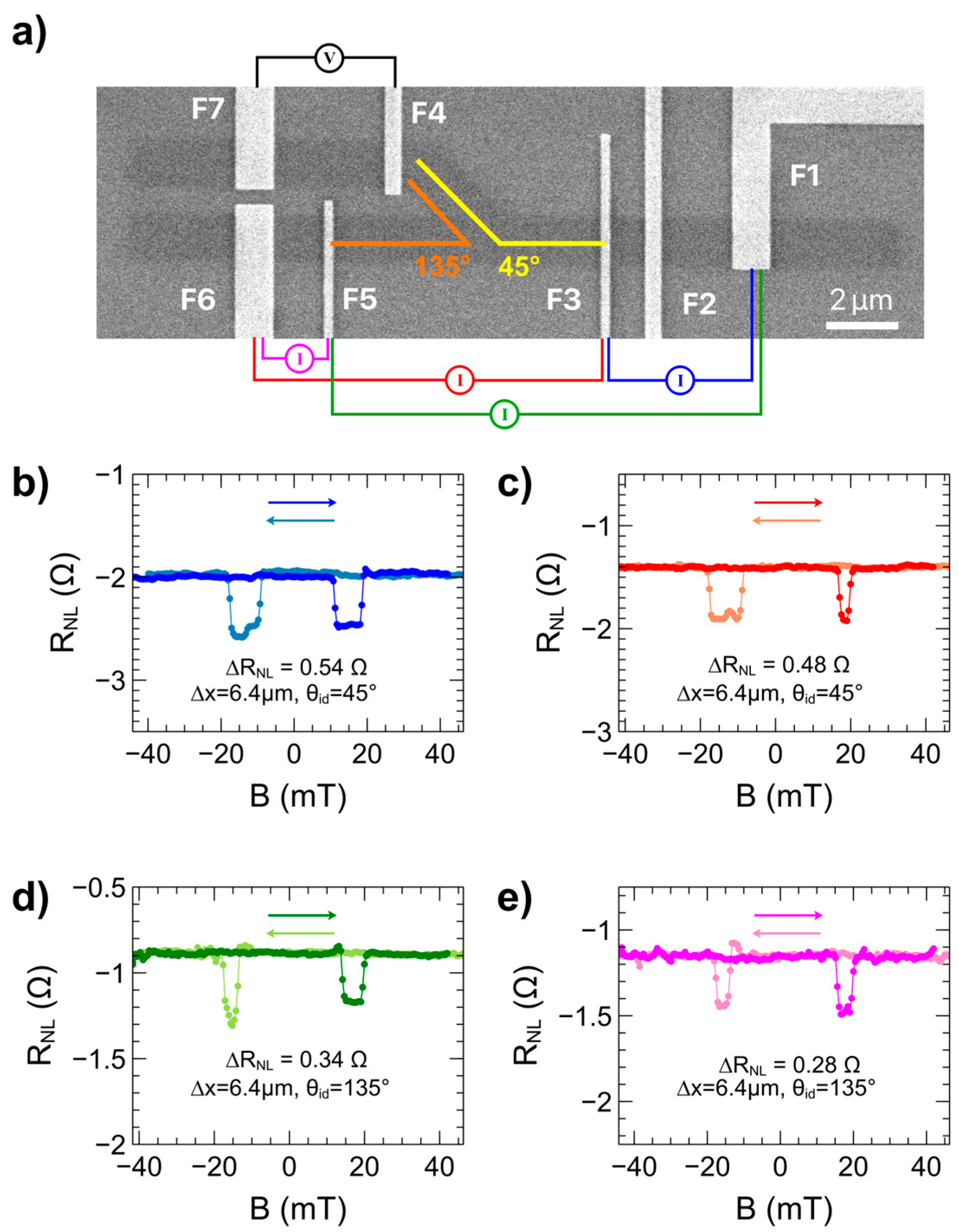
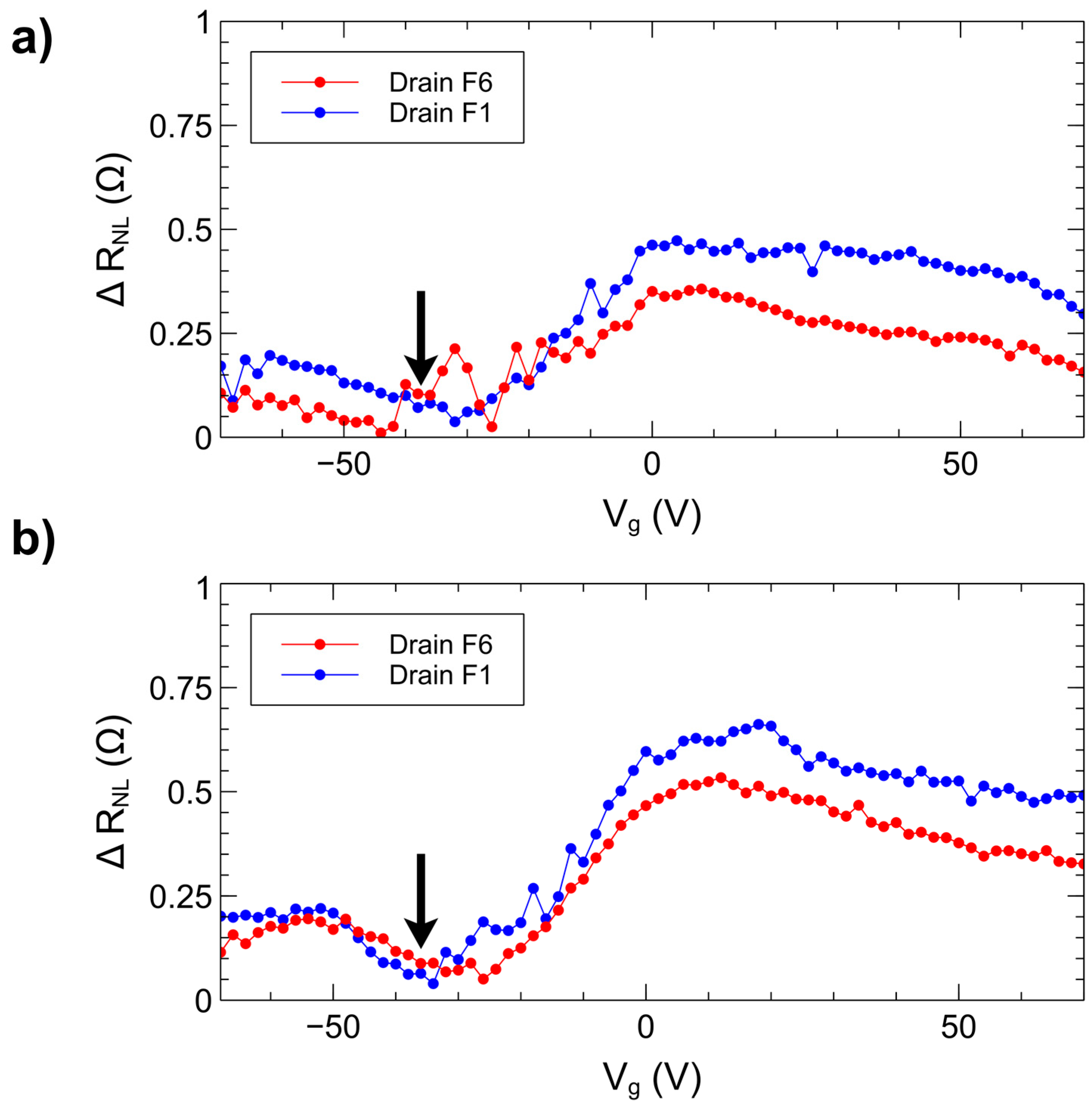
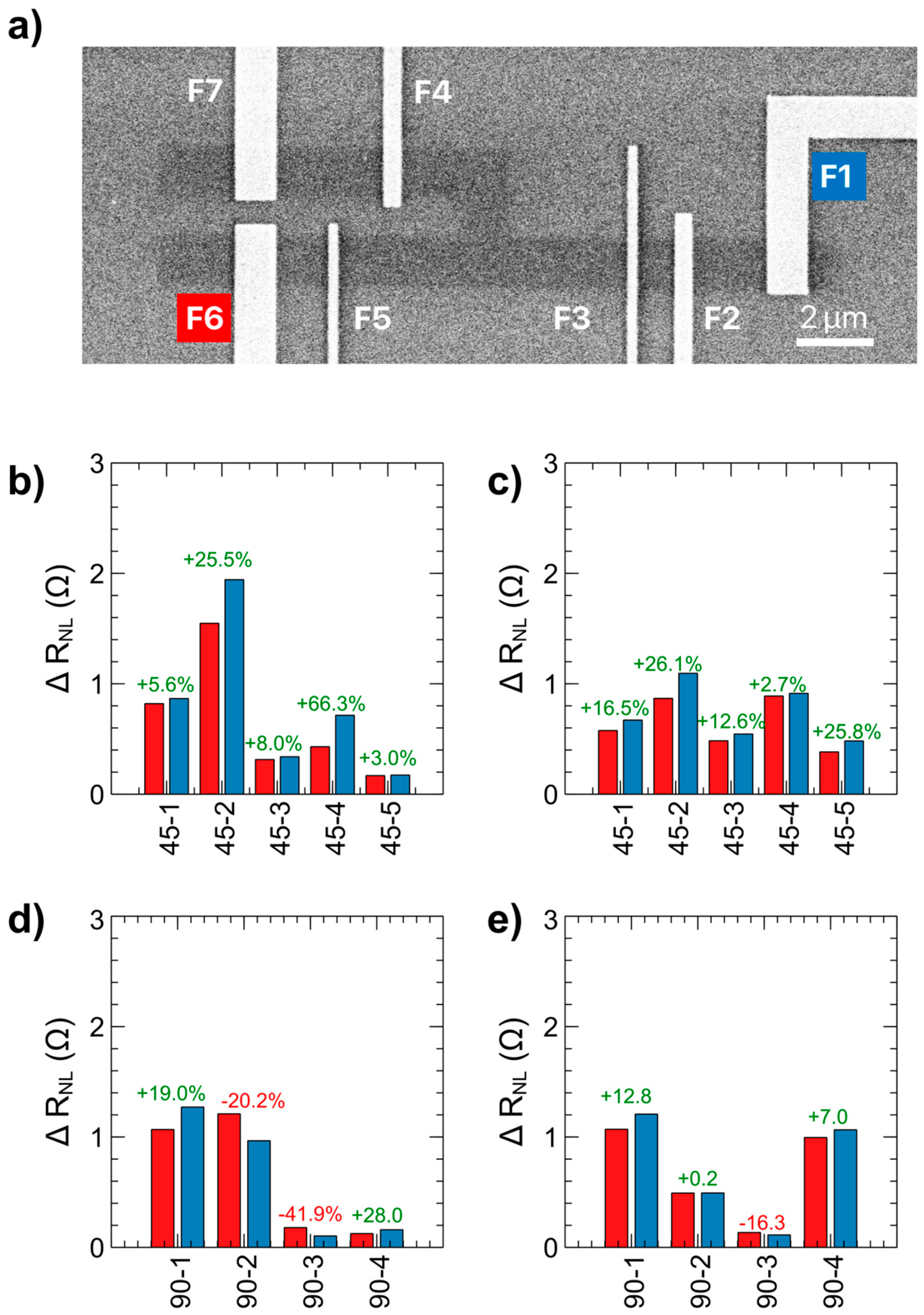
Disclaimer/Publisher’s Note: The statements, opinions and data contained in all publications are solely those of the individual author(s) and contributor(s) and not of MDPI and/or the editor(s). MDPI and/or the editor(s) disclaim responsibility for any injury to people or property resulting from any ideas, methods, instructions or products referred to in the content. |
© 2025 by the authors. Licensee MDPI, Basel, Switzerland. This article is an open access article distributed under the terms and conditions of the Creative Commons Attribution (CC BY) license (https://creativecommons.org/licenses/by/4.0/).
Share and Cite
Olson, S.; Hood, K.; Zietz, O.; Jiao, J. Enhancement of Spin Transport Properties in Angled-Channel Graphene Spin Valves via Hybrid Spin Drift-Diffusion. Nanomaterials 2025, 15, 1367. https://doi.org/10.3390/nano15171367
Olson S, Hood K, Zietz O, Jiao J. Enhancement of Spin Transport Properties in Angled-Channel Graphene Spin Valves via Hybrid Spin Drift-Diffusion. Nanomaterials. 2025; 15(17):1367. https://doi.org/10.3390/nano15171367
Chicago/Turabian StyleOlson, Samuel, Kaleb Hood, Otto Zietz, and Jun Jiao. 2025. "Enhancement of Spin Transport Properties in Angled-Channel Graphene Spin Valves via Hybrid Spin Drift-Diffusion" Nanomaterials 15, no. 17: 1367. https://doi.org/10.3390/nano15171367
APA StyleOlson, S., Hood, K., Zietz, O., & Jiao, J. (2025). Enhancement of Spin Transport Properties in Angled-Channel Graphene Spin Valves via Hybrid Spin Drift-Diffusion. Nanomaterials, 15(17), 1367. https://doi.org/10.3390/nano15171367





